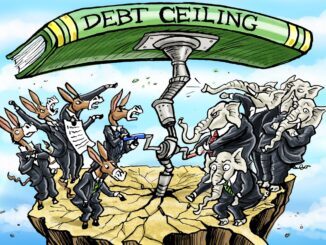
A cascade of hot inflation data seems to indicate that inflation has yet to be tamed in the United States, throwing markets into jitters amidst concerns over further interest rate hikes.
Yet the recent collapse of two US banks with big losses in their bond holdings following eight rate hikes, has given rise to fears of systemic risks, and put pressure on the US Federal Reserve (Fed) to limit further rate increases, and even to cut rates later.
At the same time, fears of a fresh round of inflation from China’s reopening, prompts questions on how much further rates should be raised?
With this uncertainty, the current selldown in US equities and emerging markets (EMs) is expected to last over the summer months, while the level of the ringgit is being watched.
As the Fed may put up a dovish stand for less rate hikes, the ringgit could appreciate but also weaken, due to higher demand for US dollars in a risk-off scenario of stress.
The decision to further hike US rates could now be impacted by the collapse of US-based Silicon Valley Bank (SVB), one of the 20 largest US commercial banks, and Signature Bank.
SVB collapsed as it had bought up bonds with deposits from customers, mostly startups and technology companies that needed the cash back quickly.
But the value of SVB’s investments had fallen as the Fed had raised rates aggressively; SVB had bought its bonds earlier at lower rates.
The current selloff in bank shares and the sharp drop in US Treasury yields suggests a growing concern over credit markets.
Interest rate futures on federal funds rates indicates expectations of a possible rate cut in the second half of 2023, said Bank Muamalat Malaysia head, economics, market analysis and social finance, Mohamed Afzanizam Mohamed Rashid.
First, the Fed is likely to signal that it will pause in its rate hikes after the next few raises, as US consumer strength is expected to wane over the next few months following numerous rate increases.
A rate cut by year-end could occur as rapid US rate hikes have suppressed markets and will eventually bite into the US economy, said Etiqa Insurance & Takaful chief strategy officer Chris Eng.
The Malaysian market will be in jitters similar to other EMs; but by year end, it should rebound.
But many consider that the inflation backdrop still supports some more rate hikes, possibly less aggressively.
OCBC Bank still believes that a 25 basis points (bps) hike is more likely; the US Federal Open Market Committee (FOMC), which meets tomorrow and Wednesday, will likely be keen to maintain its credibility by basing its policy decision mostly on the data which still indicates a high inflation rate.
US prices in February were 6% higher compared to the peak of 9.1 seen last June; despite the downtrend in the year-on-year (y-o-y) inflation rate, it remains far from the Fed’s target of 2%.
The Fed may also want to avoid being seen as panicking, when reassurance and confidence is key.
But the FOMC may need to change its forward guidance, potentially dropping the “higher for longer” narrative on rates.
Should market jitters continue, it would be tough to decide between a pause and a small rate hike, said OCBC Bank rates strategist Frances Cheung.
Overall, the stickier-than-expected round of US inflation figures have forced markets to reprice for higher US rates.
The base case remains for Fed funds rates to go up to 5.25% (currently 4.5% to 4.75%); there is a risk that the Fed may take this opportunity to reset the dot plot (projections for Fed funds rates) higher and guide for higher rates, said United Overseas Bank (M) senior economist Julia Goh.
The collapse of SVB has sparked concerns of contagion risks which are mitigated by joint measures by the US authorities to support the financial system.
The failure of SVB is more likely on an ‘idiosyncratic development’ and unlikely to have a systemic impact on the US financial sector; it is reasonable to expect the Fed to continue to stay focused on fighting inflation and push forward with its rate hike cycle, said UOB Group in a note.
Given elevated inflation despite slowing growth, there may be no room for a Fed cut later in the year, as US core inflation will likely be sticky and slow to fall off due to a tight labour market, said Maybank Investment Banking Group regional co-head, Chua Hak Bin.
The Fed may have to hike rates by at least another two rounds to contain inflationary pressure.
EM asset prices and currencies may face pressure from further Fed rate hikes but China’s reopening will give a significant boost to Asean in terms of exports, tourism and investments.
The lesson to be learned from this recent US banking crisis is that a regime of ultra low rates, as under the previous quantitative easing stimulus programme, can be costly.
It will severely constrain the Fed’s ability to raise rates to fight inflation.
The fear of fresh inflationary pressures is real as a resurgent Chinese economy amidst the ending of Covid-19 restrictions, will lead to a firming of oil prices, sending prices higher again, said former Inter-Pacific Securities head of research Pong Teng Siew.
Resulting from the earlier-than-expected re-opening, China’s growth is expected to re-accelerate to above 5% in 2023 from 3% in 2022, bucking the trend of a global slowdown.
Chinese consumers’ ability to spend from excessive savings in 2022, induced by the pandemic, may offset the weaker external demand and support China’s growth.
China’s household deposits increased by 17.84 trillion yuan (US$2.4 trillion or RM11.6 trillion) in 2022, compared to a net increase of 9.9 trillion yuan (RM6.43 trillion) in 2021.
The excessive savings will provide ammunition to China’s consumption story in 2023, especially if China is able to unlock these amounts by restoring confidence.
The contribution from domestic consumption to gross domestic product growth is expected to return to more than 50% from 32.8% in 2022, said OCBC Bank head of Greater China research and strategy, Tommy Xie.
China’s imports from Malaysia had increased by 11.8%, y-o-y in 2022, due to demand for upstream goods such as semiconductors.
Against all factors, the FOMC meeting over the next two days will be critical for markets to gauge the risk appetite among Fed members, for the magnitude of US rate hikes.
Yap Leng Kuen is a former StarBiz editor. The views expressed here are the writer’s own.
Source: asianews.network



